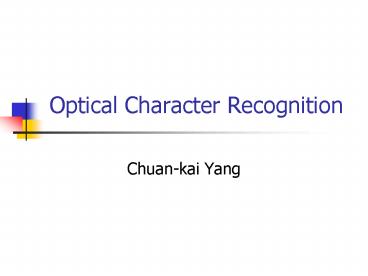Optical Character Recognition PowerPoint PPT Presentation
1 / 27
Title: Optical Character Recognition
1
Optical Character Recognition
- Chuan-kai Yang
2
Outline
- OCR Systems
- Historical Perspective
- Commercial Applications
3
OCR Systems
- Image Scanner
- OCR software/hardware
- Output interface
4
Image Scanner
- Detector
- Illumination source
- Scan lens
- Document transport
5
OCR Software/Hardware
- Document Analysis
- Character Recognition
- Contextual Processing
6
Document Analysis
- Character segmentation/isolation
- Compensate poor scanning quality
- Image enhancement
- Underline removal
- Noise removal
7
Character Recognition
- Feature extractor
- Determine the descriptors or feature set
- Derived feature set is fed into the classifier
- Classifier
- Template matching (matrix matching)
- Structural classification
- Bayesian classifier
- Artificial neural networks
8
Template Matching 1/2
- One of the most common methods
- Individual image pixels are used as features
- Classification is performed by comparing an input
character image with a set of templates(prototypes
) - Each comparison results in a similarity measure
between the input character and the template, the
comparison is pixel by pixel - The character identity is assigned the identity
of the most similar template
9
Template Matching 2/2
- Template matching is a trainable process because
template characters may be changed - In many commercial systems, PROMs (programmable
read-only memory) store templates containing
single fonts. - If a suitable PROM exists for a font then
template matching can be trained to recognize
that font
10
Structural Classification 1/2
- It utilize structural features and decision rules
to classify characters - Features may be defined in terms of character
strokes, character holes, or other character
attributes such as concavities - For instance, the letter P may be described as
a vertical stroke with a hole attached on the
upper right side
11
Structural Classification 2/2
- For a character image input, the structural
features are extracted and a rule-based system is
applied to classify the character - Structural methods are also trainable
- The construction of good feature set and a good
rule-base can be time-consuming
12
Other methods
- Discriminant function classifier use
hypersurfaces to separate the feature description
of characters - Bayesian methods seek to minimize the loss
function associated with misclassification
through the use of probability theory - ANNs, which are closer to human perception,
employ mathematical minimization techniques - These techniques are used in commercial OCR
systems
13
Recognition Rate
- For machine-printed characters, the rate can
reach over 99 - For hand-written characters, the rateis
typically lower
14
Contextual Processing
- The number of word choices for a given field can
be limited by the content of another field - Knowing the zip code can help knowing address
- Post processing to correct recognition error
- Spelling checker
- Verified interactively by the user
15
Non-Roman Character Recognition
16
Output Interface
- The output interface allows character recognition
results to be electronically transferred into the
domain that uses the results - Spread sheets
- Databases
- Word processors
17
Historical Perspective
- Born in 1951 GISMO by M. Sheppard a robot
reader-writer - 1954 J. Rainbow developed a prototyped machine
that was able to read uppercase typewritten
output at the fantastic speed of one character
per minute - Systems that cost one million dollars were not
uncommon
18
Some ANSI Standard Fonts
machine
machine
handwritten
19
Todays OCR Systems
- It is not uncommon to find PC-based OCR systems
for under 800 capable of recognizing several
hundred characters per minute - Some system advertise themselves as
omnifont-able
20
Commercial Applications
- Task-Specific Readers
- Assigning ZIP codes to letter mail
- Reading data entered in forms, e.g. tax forms
- Automatic accounting procedures used in
processing utilities bills - Verification of account numbers and courtesy
amounts on bank checks - Automatic accounting of airline passenger tickets
- Automatic validation of passports
21
Address Readers
Up to 400 fonts, and up to 45000 mail pieces per
hour.
22
Form Readers
- Trained with a blank form
- Scan regions that should be filled with data
- Some system can process forms at a rate of 5800
forms per hour
23
Check Readers
- Capture the check image
- Cross reference the amounts specified at both
places - An operator can correct misclassified characters
by cross-validating the recognition results
24
Bill Processing Systems
- Focus on certain regions on a document where the
expected information are located - Account number
- Payment value
25
Airline Ticket Readers
- Scan/Match
- Reservation record
- Travel agent record
- Passenger ticket
- Some systems can scan tickets upt to 260000
tickets per day (17 tickets per second)
26
Passport Readers
- Reads the travelers
- Name
- Date of birth
- Passport number
- Match against the database records containing
information on fugitive felons and smugglers
27
General Purpose Page Readers
- High-end higher data throughput and more
advanced capabilities - Can adapt the recognition engine to customer data
to improve accuracy - Can even detect type face (bold face and italic)
- Low-End
- Mostly used in an office with desktop
workstations - Could handle a broad range of documents at a
lower rate and accuracy

